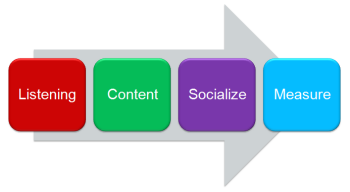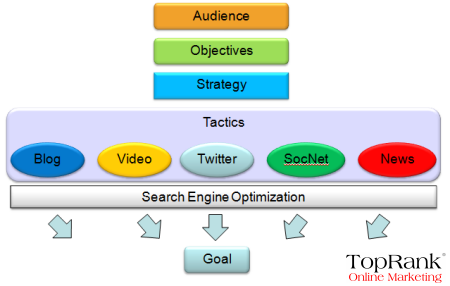Listening, Content, Socialize and Measure
Lee goes in a good detail about each step in his article.
I really liked his suggestions on what to listen to.
- Social Channels – Which social destinations are your customers frequenting?
- Social Keywords – Good social media monitoring tools analyze tags, comments, anchor text and other forms of text to identify keywords associated with the monitoring topic. That keyword insight can help identify topics of interest as they emerge and influence content strategy decisions as well as social media optimization. Social conversations influence search behaviors and if you can identify relevant concepts that are emerging in popularity on the social web, why not create and optimize content around those topics so you’re easily found via search engines?
- Influentials – A listening program will help identify the influentials within the topics you’re monitoring providing the ability to prioritize who to connect with.
- SERPs – Social media monitoring tools don’t track search engine results pages and that’s why you should. All major search engines purchase data feeds from different social media sources and incorporate social media content within search results. Therefore, it’s important to monitor search results for key terms relevant to your business and identify what social sources are being included. If Google is showing blog posts above the fold for a competitive keyword phrase, it might be easier for you to get exposure by commenting on those blog posts with a link back to your site or making blog posts about that topic on your own blog.
One of the biggest growth areas in Online Marketing is the business of creating, optimizing and promoting content. It’s no longer enough to simply publish features and benefits information on products and services. Customers want more. Marketers would do well to create a content marketing strategy or as I like to call it, a Content Marketing Optimization Strategy. Inventory content assets such as web pages, images, video, audio, rich media and file types such as HTML, PDF, MS Office docs, Structured Data Feeds and RSS to assess what can be promoted via social channels and be ranked in search results. Map search keywords to search engine optimization content. Map social keywords to social media content.
Three key pieces to socializing your marketing efforts include:
- Buyer Personas – Research what your customers do on the social web. What are their social information discovery, consumption and sharing preferences. What influences them to share and buy?
- Grow Networks – Time strapped marketers often fail to spend time growing networks. Some try to buy friends literally or through repeated incentives. Spend a small, but consistent amount of time growing networks organically. That might mean 10-30 minutes every day commenting, friending, following, liking and updating on a daily basis. There is no substitute for participation when it comes to growing a network that can have a real effect on your ability to promote content that gets passed on and on and on.
- Promote – Plan to develop a cycle of social interaction by reconciling the needs of buyer personas with business goals in your content marketing strategy. Grow networks that you can promote optimized content to. Blogs can often serve as an ideal hub for this kind of content with spokes to the various social channels for content promotion such as YouTube, Twitter, Facebook, etc.. A cycle of social participation starts with creating & promoting optimized content & assets. That content gets noticed, shared & voted on, growing awareness. The increased exposure attracts more subscribers, fans, friends, followers & links. Increased links & social exposure grow search & referral traffic. Traffic & community help with research to develop & further grow your social networks for content & SEO.
Leveraging monitoring and analytics to inform future content creation, keyword optimization and social promotion is essential for staying ahead of the competition and being effective at meeting customer needs.
Develope an overall Social Media Roadmap.
1. Increase Your Linkability
Adding a blog is a great step.
Check out what Darren Rowse recently created as a great example – he built a workbook that was made up of content already published on his blog, and yet his community still supported himin sharing it even though it’s material that is already public. He repurposed blog posts into a more formal/packaged format and is now selling the final product. This makes a lot of sense – publish the content bit by bit to attract links, traffic and subscribers as you go, then at the completion turn it into something polished.
2.Make Tagging and Bookmarking Easy
3. Reward Inbound Links (This may be a strategy but I would be hesitant to classify it as rule)
[Lee: There are many ways to implement a quality link recognition process. Here are two examples that we use at TopRank:
1) The BIGLIST of Search Marketing Blogs suggests to other blogs that the only way to get on the list is to be noticed by TopRank. One effective way to get noticed is if other blogs link to BIGLIST. There are about 74k links to BIGLIST so far.
2) Each month and recently, each week, we post a roundup of media and blog coverage that TopRank gets on a newsroom blog post. Each time a mainstream publication or prominent website/blog mentions our brand or key staff, we include a link back to that source in our roundup.
4.Help Your Content Travel
Lee: Building channels of distribution for content can be a very effective way to gain exposure and attract links. Email newsletters, RSS subscribers, status updates, Twitter updates, content syndication and promotions can all improve reach. Exactly how far that content travels depends on how congruent it is to the needs and interests of the network empowered to pass it along.
5.Encourage the Mashup
Encourage reuse, remix and sharing for ideas to spread – at the end of the day the benefits still flow back to the originator of said content. People are going to reuse your content anyway, it’s the nature of the social web. Better to embrace it than fight it. Trent Reznor is a great case study of an artist who understands this philosophy.
6. Be a User Resource, Even if it Doesn’t Help You
Add value to users, including outbound links to areas that could help them with their goals and purposes. Deployed corrected, even if you link to competitors you stand to gain as the communities first source of information finding. How will this help SMO? Folks will link to your social site and tag is as helpful or the ‘ultimate’ guide in that space. As this adds up, it will become more and more relevant in search engine results.
7. Reward Helpful and Valuable Users: go beyond telling people you appreciate them, form a relationship with them
8. Participate
Join the conversation. Social Media is a two way street, lets not forget that. By conversing with the community you are creating awareness and prolonging your buzz. You are keeping it going and this often results in a snowball effect. Participating helps your message spread further and faster.
9. Know How to Target Your Audience
I would love to have everyone using my product too, but you need to be realistic. There is always going to be a certain audience you can appeal to and others that you can’t. So know your appeal and who it is appealing to. You have to understand both the subject matter and the community living and breathing it.
10. Create Content
11. Be Real
The community does not reward fakers.
12. Don’t Forget Your Roots, Be Humble
13. Don’t Be Afraid to Try New Things, Stay Fresh
14. Develop a SMO Strategy
15. Choose Your SMO Tactics Wisely
Choose your SMO tactics wisely. Be cognizant of what actions will influence the desired outcome with the most impact. Definitely, what’s right for one brand or industry may not be for another.
16. Make SMO part of your process and best practices
How to Measure Social Media Traffic with Google Analytics
The reality is text is still king of the web and we’ve been socializing this way since the days of message boards and forums in the 90’s.
Good marketing itself is not about the platform, it’s about the idea. The platform is merely an enabler, but to utilize it effectively comprehension is vital. With social media gaining popularity daily it is necessary for marketing professionals and businesses alike to comprehend this dynamic communication enviornment. And the only true way to accomplish this is to become involved yourself.
Here is interesting information on how to measure SMO from 7 Steps For a Successful Social Media Strategy
Measure Results
You have goals and objectives, right? That means you should be able to measure your success.
Remember, what you measure will tie into the goals and objectives of your social media strategy.
Let’s take the four commonly used objectives:
Here is interesting information on how to measure SMO from 7 Steps For a Successful Social Media Strategy
Measure Results
You have goals and objectives, right? That means you should be able to measure your success.
Remember, what you measure will tie into the goals and objectives of your social media strategy.
Let’s take the four commonly used objectives:
- Improve brand presence across social channels—The measurement goal here is an increase in the number of followers on Twitter, number of fans on Facebook, number of comments, number of times your brand is mentioned in blogs and forums and so on.
- Increase positive sentiment about your brand—The goal here is to convert the number of positive mentions while taking note of negative mentions. Has the ratio of positive to negative comments improved? With the good comes the bad in social media. Get used to it!
- Develop relationships for future partnership opportunities—This goal is to keep track of those with whom you’ve connected. For example, if you met a potential speaker for your webinar, include that person into your digital Rolodex. If a vendor contacts you through your blog, capture that lead and take note.
- Increase traffic to your website—Keep track of visitors to your website who come from each of your social media sites. If you’re promoting an event using social media, consider using a unique code to track the campaign.
And here is a very useful video on
How to Measure Social Media Traffic with Google Analytics
All images were taken from the first article.
Here Are 3 Major Search Engine Facts from this article
- Google is now including Twitter conversations in search results. This means that if I search for the keyword phrase, “earthquake in California” I will see the latest real-time conversations about those keywords from twitter.
- Social Media sites are being indexed at a much higher frequency than the average site. For example, when I update my active public facebook profile or fan page, google will see it in at least an hour.
- The most popular Social Media sites are trusted by google and usually have high page ranks
I highly recommend to read
Free Tools for Social Media Optimization or 5 Social Media SEO & Analytics Tools Worth Checking Out
The website I'm working on is http://kcswindowcleaningandsunscreens.com/contacts/sun-screens.php


No comments:
Post a Comment